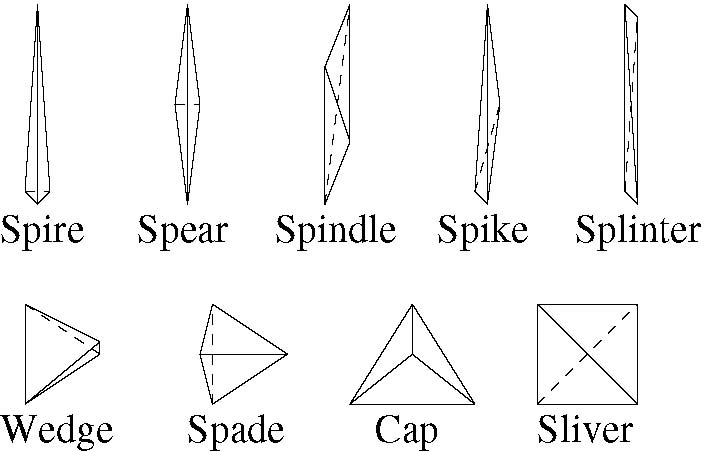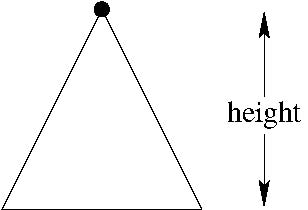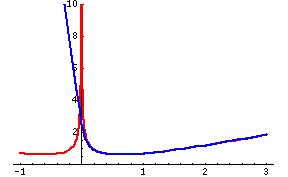The Simplex Package
Simplicial Quality Measures
For the finite element method, the simplicial elements of the mesh should be ``well-shaped'' to ensure accuracy and stability of the solution.
Large angles reduce interpolation accuracy. Small or large angles increase the condition number of the stiffness matrix. Poorly conditioned elements slow down solvers and introduce large roundoff errors.
Below are the nine ways the vertices of a tetrahedron may become nearly colinear or coplanar.

Degenerate tetrahedra.
Geometric Quality Metrics
Geometric quality metrics are a function of the geometry of the simplex
- Maximum or minimum dihedral angle (angle between faces).
- Aspect ratio (ratio of inscribed to circumscribed sphere).

The dihedral angle and the insphere and circumsphere used to calculate the aspect ratio.
Algebraic Quality Metrics
Algebraic quality metrics are a function of the Jacobian matrix of the affine map that transforms the reference (equilateral) simplex to the physical simplex. The  Jacobian matrix
Jacobian matrix  has information about the volume, shape and orientation of the element.
has information about the volume, shape and orientation of the element.
In 3-D, the condition number metric is  .
.  becomes singular when the element volume vanishes.
becomes singular when the element volume vanishes.  measures the distance from singular matrices.
measures the distance from singular matrices.
In 3-D, the mean ratio metric is  .
.
These metrics are unity for the equilateral tetrahedron and are singular for tetrahedron of zero volume.
These two algebraic quality metrics have a number of desirable properties.
- They are sensitive to all types of degeneracies. (Freitag and Knupp.) For example, the dihedral angle quality metric does not detect spears, spindles or spires.
- Their definition is dimension independent. (In this implementation the dimension is a template parameter.)
- They have continuous derivatives. This enables optimization methods that use the gradient and Hessian.
Metrics for Inverted Elements
Because of their singularities, these algebraic metrics cannot be used to optimize meshes with inverted elements. Even for good quality meshes, the optimization algorithm may assess the quality of inverted elements in trying to improve the mesh.
We implement the condition number and mean ratio metrics presented in ``Simultaneous Untangling and Smoothing of Tetrahedral Meshes'' by Escobar et al. They modified the metrics to be defined for inverted elements.

Iscosoles triangle of varying height.

The modified and unmodified mean ratio metrics for the triangle are shown in blue and red, respectively.
Content
The Simplex package has algebraic quality metrics for simplices (triangles, tetrahedra, etc.). There are four quality functions: condition number, modified condition number, mean ratio and modified mean ratio. The condition number and mean ratio metrics are defined for simplices with positive content (hypervolume). The modified versions are defined for simplices with positive, zero and negative content.
This package has implementations of the work presented in ``Simultaneous Untangling and Smoothing of Tetrahedral Meshes'' by Escobar et al. in Computer Methods in Applied Mechanics and Engineering, 192 (2003) 2775-2787. Also see:
- "Algebraic Mesh Quality Metrics", by Patrick M. Knupp, SIAM Journal of Scientific Computing, Volume 23, Number 1, pages 193-218.
- ``Tetrahedral Mesh Improvement via Optimization of the Element Condition Number'' by Lori A. Freitag and Patrick M. Knupp.
Classes
The four classes which implement the quality metrics are:
- geom::SimplexMeanRatio is the mean ratio quality function.
- geom::SimplexModMeanRatio is the modified mean ratio quality function.
- geom::SimplexCondNum is the condition number quality function.
- geom::SimplexModCondNum is the modified condition number quality function.
These quality metric clases inherit or use functionality from the following classes.
- geom::Simplex is a simplex in N-D.
- geom::SimplexJac implements the Jacobian matrix of the transformation from the identity simplex.
- geom::SimplexAdjJac implements the adjoint of the Jacobian matrix of the transformation from the identity simplex.
- geom::SimplexModDet modifies the determinant of the Jacobian matrix so that quality functions can be defined Jacobian matrices with non-positive determinants.
- geom::SimplexJacQF is a base class for quality functions using the Jacobian.
- geom::SimplexAdjJacQF is a base class for quality functions using the adjoint of the Jacobian.
Finally, there are classes for assessing the quality of a complex of simplices that are adjacent to a vertex.
- geom::SimplexWithFreeVertex is a quality function applied to a simplex with a free vertex.
- geom::ComplexWithFreeVertex holds the simplices which are incident to a free vertex.
Use these classes by including the file geom/mesh/simplex.h .
Generated on Thu Jun 30 02:14:58 2016 for Computational Geometry Package by
 1.6.3
1.6.3